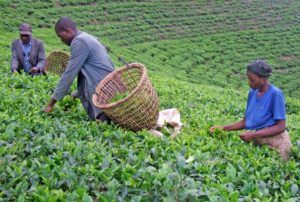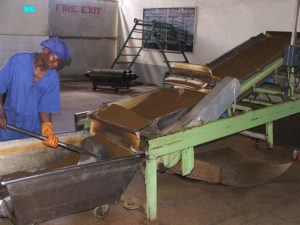TOO HOT FOR YOUR TEA TO BREW?

How tea farmers challenge climate change
A myth ties the origins of tea to an errant gust of wind that blew tea leaves into a Chinese emperor’s hot water more than 4,700 years ago. Ever since, tea is one of the most commonly consumed beverage.
The Kayonza Growers Tea Factory is a cooperative situated in Kanungu District, 25kms away from Bwindi National park, a rainforest in the south western part of Uganda. The factory is fully owned by over 5,000 small scale shareholders who acquire shares through monthly deductions from their pay for green leaf delivered to the factory.

Over 90% of the Kayonza community members are dependent on locally-sourced wood for energy, leading to high deforestation rates. According to the UNDP, the Kayonza community is not only facing deforestation, but also prolonged drought, wetland encroachment, soil degradation and water shortages due to increasing effects of climate change.
Unlike many agricultural products, tea bushes are consistently planted for 60 years so it’s the same bush that is being plucked every year instead of a re-planted crop. Tea is therefore more responsive to the climate rather than the weather. Studies on the impact of climate change have shown that an average temperatures rise by 2.3 degrees celsius by 2050 could potentially wipe out Uganda’s most profitable tea producing areas, with severe losses in productivity already apparent by 2020.

Small scale tea farmers, such as the Kayonza farmers, are even more vulnerable to climate change impacts because of limited options and resources available for adaptation. The result has been low tea production, food scarcity and decline in household revenues.
The Kayonza factory operations are overseen by a General Manager, assisted by five department heads. The company manufactures Black teas with production of up to 3,000 tones annually. Primary grades make about 90% and Secondary grades make 10% of the total production. High quality products are essential for export revenues and overall financial performance.

A worker shovels tea onto an electricity run mill at Kayonza tea factory in Kanungu
At the Factory level, weather variability can have very negative effect on the business operations and economics through:
- Higher susceptibility of supply chain disruptions, high inventory and stock outs due to higher frequency of extreme weather events
- Higher costs for prevention activities to mitigate the effects
- Higher prices for insurance
- High equipment cost to make certain equipment to prevent floods, or construction of water retention infrastructure such as dams.
Kayonza and its distributor partner (Cafedirect PLC) have developed a climate change adaptation strategy to counter the effects of climate change by implementing innovative agricultural and management practices. According to the UNDP, “the initiative has worked to ensure that at least 70 percent of the population is involved in a landscape-scale, community-led climate change adaptation and mitigation strategy that addresses energy efficiency, food and income security and natural resource management.”
Overall the farmers of the Kayonza Tea Factory will be trained to implement climate change adaptation measures along four areas of strategy:
- Management of pest and diseases: The strategy will focus on early planting, use of resistant varieties, early detection and control techniques and research on new diseases.
- Food security: Efforts to increase food production will be sought by adopting better farming methods in crop and tea farming systems. Outside of tea production, the farmers will plant new varieties of crops and food and make better use of organic and inorganic fertilizers.
- Family Planning: Programs for farmers will be conducted on family planning using radio programs and farmer’s trainings to combat food scarcity and poverty
- Nature Conservation: The strategy will aim at planting of approximately 5000 trees in degraded areas, implementing energy saving technologies at farm level and protect swamps and wetlands. Currently, only about 30% of tea estate are planted with trees but by the end of the project, all estate boundaries will be planted.
In addition to the actions the Company is currently undertaking, further steps can be taken to:
- Increase the labor force to include a higher number of factory workers in charge of fetching water. Given the low labor cost, this could increase yields at lower
- Audit the manufacturing facilities and processes to implement energy efficient actions that have short payback time. For instance, replacing incandescent lamps with compact fluorescent lamps or light emitting diodes (LEDs) can reduce energy consumption. Furthermore, the factory could ensure that maintenance is frequent enough to prevent efficiency losses and reduce heat losses or gains.
- Increase labor efficiency and tea plants productivity by training the farmers to adopt good agricultural practices. For instance, in a tea farm in Kenya, farmers have been taught to leave tea prunings at the site, to enhance soil fertility and water retention. This has proven to improve tea yields. (793 words)
Mitigating Climate Change in the Tea sector
Kayonza Growers Tea Factory recognized for its Equator Prize Win
Effects of Climate Change on Factory Life Cycle
Climate Change and the Energy Manufacturing Sector
http://cdkn.org/wp-content/uploads/sites/4/2015/04/Climate-Change-and-the-Energy-Sector.pdf
How can small-scale coffee and tea producers adapt to climate change?
UN Case study: Climate change adaptation strategy for Kayonza Growers Tea Factory
Impacts of Climate Change Felt by Tea Producers
http://www.ethicalteapartnership.org/impacts-climate-change-felt-tea-producers/
Climate change is a threat – and an opportunity – for the private sector
Climate Change Poses a Brewing Problem for Tea
http://www.climatecentral.org/news/climate-change-altering-tea-industry-19071
Exhibits



Amy, this blog stuck out to me because so many organizations have few incentives to manage climate change, yet the survival of the Kayonza community seems dependent on its ability to adapt to changes in weather. However, the term “survival” stuck in my mind the entire time I was reading your blog post. The Kayonza’s plans were merely aiming for a best case scenario of survival — when talking about things like population management, we’re merely delaying the inevitable collapse of the community rather than aiming to thrive. I have to wonder whether there are innovations in the types of tea plants or the access to water that could give this community a better chance to thrive.
It’s interesting to hear about how tea is susceptible to weather, because we’re normally exposed to shortage of other crops and you would imagine tea and coffee have constant supply in the market. In the end, it seems like there needs to be a more fundamental change in the way of growing crops on top of the suggestions made above. As climate change is a real threat and farms will eventually transition to new cropping methods to be adaptive, I wonder if they’re exploring more innovative changes in the method rather than optimizing for the near future.
As a prolific drinker of tea, this post really resonates with me. It seems like Kayonza is trying to mitigate the effects of and on climate change but it doesn’t seem like they’re doing enough / through the right channels. For example, I understand the point about family planning but it seems to be addressing a symptom rather than addressing the cause. As such, I appreciate your ideas for what more Kayonza can do. I don’t quite follow how having more workers fetch water will help in a meaningful way? Auditing for energy efficient practices seems like a no-brainer as well as good agricultural practices. If only we can implement! Thanks for the interesting read